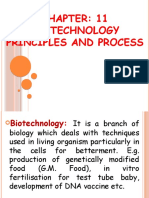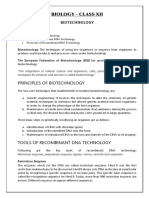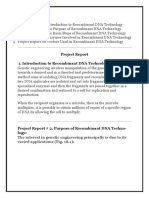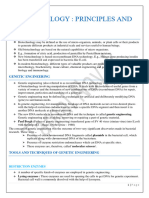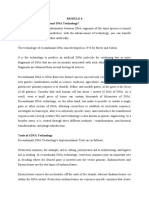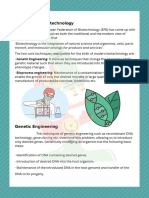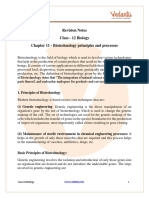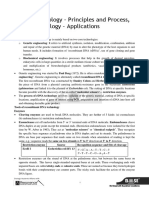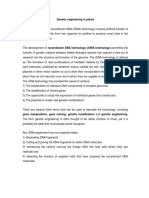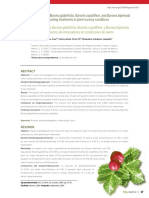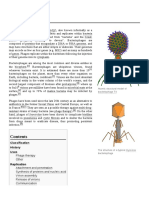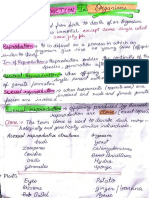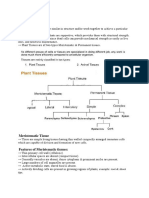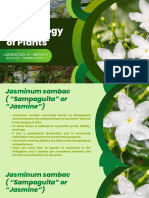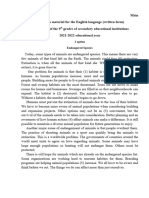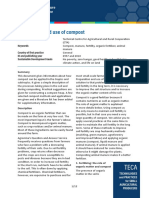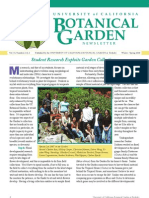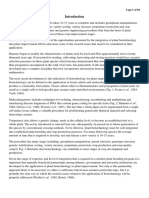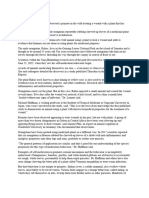0 ratings0% found this document useful (0 votes)
84 viewsChapter 11 Sub
Chapter 11 Sub
Uploaded by
shreya sardesaiBiotechnology uses living organisms or enzymes from organisms to produce useful products and processes. Modern biotechnology employs genetic engineering techniques like recombinant DNA to produce products on a large scale. The key techniques that enabled genetic engineering are genetic manipulation, tissue culture, and the construction of the first recombinant DNA molecule by Cohen and Boyer in 1972. This involved isolating genes, inserting them into plasmids, and transferring the recombinant plasmids into bacteria to replicate the genes.
Copyright:
© All Rights Reserved
Available Formats
Download as DOCX, PDF, TXT or read online from Scribd
Chapter 11 Sub
Chapter 11 Sub
Uploaded by
shreya sardesai0 ratings0% found this document useful (0 votes)
84 views22 pagesBiotechnology uses living organisms or enzymes from organisms to produce useful products and processes. Modern biotechnology employs genetic engineering techniques like recombinant DNA to produce products on a large scale. The key techniques that enabled genetic engineering are genetic manipulation, tissue culture, and the construction of the first recombinant DNA molecule by Cohen and Boyer in 1972. This involved isolating genes, inserting them into plasmids, and transferring the recombinant plasmids into bacteria to replicate the genes.
Original Description:
Biology class 12th chapter notes biotechnology and it's principles
Copyright
© © All Rights Reserved
Available Formats
DOCX, PDF, TXT or read online from Scribd
Share this document
Did you find this document useful?
Is this content inappropriate?
Biotechnology uses living organisms or enzymes from organisms to produce useful products and processes. Modern biotechnology employs genetic engineering techniques like recombinant DNA to produce products on a large scale. The key techniques that enabled genetic engineering are genetic manipulation, tissue culture, and the construction of the first recombinant DNA molecule by Cohen and Boyer in 1972. This involved isolating genes, inserting them into plasmids, and transferring the recombinant plasmids into bacteria to replicate the genes.
Copyright:
© All Rights Reserved
Available Formats
Download as DOCX, PDF, TXT or read online from Scribd
Download as docx, pdf, or txt
0 ratings0% found this document useful (0 votes)
84 views22 pagesChapter 11 Sub
Chapter 11 Sub
Uploaded by
shreya sardesaiBiotechnology uses living organisms or enzymes from organisms to produce useful products and processes. Modern biotechnology employs genetic engineering techniques like recombinant DNA to produce products on a large scale. The key techniques that enabled genetic engineering are genetic manipulation, tissue culture, and the construction of the first recombinant DNA molecule by Cohen and Boyer in 1972. This involved isolating genes, inserting them into plasmids, and transferring the recombinant plasmids into bacteria to replicate the genes.
Copyright:
© All Rights Reserved
Available Formats
Download as DOCX, PDF, TXT or read online from Scribd
Download as docx, pdf, or txt
You are on page 1of 22
CHAPTER 11 BIOTECHNOLOGY: PRINCIPLES AND PROCESSES.
Biotechnology deals with techniques of using living organisms or
enzymes from organisms to produce products and processes useful to humans.
In this sense making curd, bread, or wine are all microbe mediated
processes could also be considered as a form of biotechnology.
Now a day’s biotechnology use genetically modified organisms to
produce products useful to human beings on a large scale further many
processes /techniques are also included under technology.
Techniques of biotechnology: In vitro leading to a test tube baby
synthesing a gene and using it, developing a DNA vaccine or correcting a
defective gene are all part of biotechnology.
The European federation of biotechnology has given a definition of
biotechnology that combines both the traditional view and the modern
emphasis
The definition given by EFB is as follows:
The integration of natural science and organisms, cells, parts thereof, and
molecular analogues for products and services.
PRINCIPLES OF BIOTECHNOLOGY: The core techniques that enabled
birth of modern biotechnology are:
Genetic engineering: This includes techniques to alter the chemistry of
genetic material (DNA and RNA), to introduces this material in to host
organisms and thus the phenotype of the host organism.
Tissue culture: This involves the growth of only the desired
microbe/eukaryotic cell in large quantities for the manufacture of
biotechnological products like antibiotics, vaccines, enzymes, etc.
Constriction of the first artificial recombinant DNA molecule:
(rDNA)American geneticist, Stanley Cohen and Herbert Boyer
accomplished the construction of first recombinant DNA in 1972.
CHAPTER 11 BIOTECHNOLOGY Page 1
Cohen and boyer used a restriction endonucleaes called ECORI, which
was obtained from Escherichia coli to cut the plasmid of salmonella
typhimurium.
The antibiotic resistance gene (transgene) was also isolated by cutting out
of a piece of DNA from a plasmid which had the antibiotic resistance gene.
The cutting of DNA in both cases was done by the same restriction
endonucleaes known as the molecular or biological scissors.
The piece of DNA having antibiotic resistance gene was then linked with
the plasmid DNA of salmonella with the help of DNA ligase.
The new combination of circular autonomously replicating DNA created
in vitro is known as recombinants DNA.
The plasmids containing DNA was then transferred into E. Coli
As E. coli reproduced, it formed a clone of cells that all contained the
DNA fragment, ie antibiotic resistance gene.
This process of replication of gene is done with the help of enzyme DNA
polymerase and the process of production of multiple copies of the antibiotic
resistance gene is called cloning.
Three basic steps to make a generically modifying organisms are:
I. Identification of DNA with desirable genes.
II. Introduction of the identified DNA into the host.
III. Maintenance of introduced DNA in the host and transfer of the DNA to
its progeny.
Recombinant DNA (rDNA) technique: It involves the formation of
recombinant DNA and then its insertion into a suitable host. The sequences of
steps in rDNA technology are as follows.
To obtain culture cells with required DNA. The culture of cells with
required DNA is obtained by culture technique.
1. Selection of specific restriction endonucleaes. The specific restriction
endonucleaes is selected from the specific bacterium.
CHAPTER 11 BIOTECHNOLOGY Page 2
2. Isolation of a desired gene. By the use of enzymes called restriction
endonucleaes a desired gene (From a DNA fragment) is isolated from donor
DNA. These enzymes act like biological scissors that cleave DNA at specific
sites.
3. Isolation and cleaving of a plasmid. Some bacteria like E. coli contain
extra chromosomal circular DNA called Plasmid. The plasmids are isolated
from a culture of E. coli and cleaved or split by using the same restriction
enzymes. Restriction enzymes cleave DNA in such a way that they leave
chemically sticky end pieces it is possible to attack a gene with sticky ends to
the complimentary sticky ends of a cut-opened plasmid.
4. FORMATION OF RECOMBINANT DNA: The isolated gene is
inserted into the plasmid with the help of enzyme ligase. This technique of
joining DNA fragment of one organism to DNA molecule of another organism
is called gene splicing. The hybrid DNA molecule thus formed is called
recombinant plasmid.
5. INSERTION OF PLASMID MOLECULE IN TO ESCHERICHIA
COLI: The recombinant plasmids are mixed with the plasmid free Escherichia
coli. These Escherichia coli are treated with calcium chloride to make up by
bacteria.
6. MULTIPLICATION OR CLONING OF GENE: As Bacteria
Escherichia coli multiply, they produce identical copies or clones of
themselves. This way millions of copies of the desired gene are formed.
7. The clones of bacteria then manufacture the protein of the gene
introduced.
TOOLS OF RECOMBINANT DNA (rDNA) TECHNOLOGY: Three basic
tools required for recombinant DNA technology, they are
CHAPTER 11 BIOTECHNOLOGY Page 3
1. ENZYMES: These are DNA modifying enzymes like:
Restriction endonucleaes:
They are known as molecular scissors. They can cut DNA at specific locations
from a plasmid as well as from the foreign DNA in such a way that they leave
single stranded portions called sticky ends both at the plasmid as well as the
foreign DNA.
DNA LIGASES:
When cut by the same restriction endonucleaes the resulting DNA fragments
have the same kind of sticky ends and these can be joined together using DNA
ligases.
Hence DNA ligases join the piece of foreign DNA with the cut plasmid making
it a circular plasmid again. Now the circular plasmid contains the plasmid
genes as well as the foreign gene .They are also obtained from bacteria.
DNA POLYMERASE:
They are also obtained from bacteria. They replicate DNA i .e synthesise a new
strand of DNA from existing DNA. Hence they help in cloning of the genes.
RESTRICTION ENDO NUCLEASES:
In genetic engineering experiments the most important requirement is to cut the
foreign DNA (desired gene) and the plasmid DNA in such a way that the
desired fragment of foreign DNA can be permanently incorpoted in to the
plasmid.
The cutting of DNA is performed by restriction endonucleaes that recognise
and cleave specific sequences of nucleotides in DNA
DISCOVERY OF RESTRICTION ENDONUCLEASE:
Bacteria contained certain enzymes called restriction endo nucleases that
could fragment viral DNA as soon as it entered the bacterial cells.
CHAPTER 11 BIOTECHNOLOGY Page 4
Many of these restriction endonucleaes could recognise specific
nucleotide sequences in a DNA strand and cleave the DNA at a particular
place.
Bacteria had developed a mechanism to escape the cleavage of their own
DNA by restriction endonucleaes
They modified their own DNA using other enzymes called methylases
which added methyl (-cH3) group to some of the nucleotides in their own DNA
When the nucleotides were recognised by restriction endonucleaes are
methylated the endonucleaes could not bind with them and cleave. Hence
bacterial DNA gets protected while viral DNA gets cleaved.
How do restriction endonucleage cut DNA?
Restriction endonucleaes function by inspecting the length of
asequence.once it find the specific recognition sequence it binds to DNA
The sequences recognised by endonucleaes are typically 4-6 nucleotides
long and are palindromes, so they are called pallindromic nucleotide
sequences.
PALINDROMES:
Palindromes is the term given to a group of letters that form the same words
when read from both forward and backward, for example MALAYAM when
written from left to write and right to left, it will be MALAYAM.
Hence the same word is read in both the direction s it is called a word
palindrome
PALINDROME NUCLEOTIDE SEQUENCES: The palindrome in DNA is
a sequence of nucleotide base pairs that read the same on the two strands of
DNA when orientation of reading is kept the same.
Example: in strand 51 to 31direction the sequence read as GAATTC
while in strand B in 51 to 31direction, it will again read the same in both the
strands. Such nucleotide sequences are called pallindromic nucleotide
sequences.
CHAPTER 11 BIOTECHNOLOGY Page 5
Naming of the restriction endonucleaes enzymes: The restriction
endonucleaes enzymes are named by the following convention:
The first letter of the name comes from the genus of the organism they
are isolated from.
The second two letters of the name come from the species of the
organism from which they are isolated.
The next letter refers to the name of the strain.
Roman number at end refers to the order in which enzyme was isolated
from bacteria.
Example restriction endonucleaes EcoRI was isolated from bacterium,
Escherichia coliRY13 the letters of EcoRI refer as given below.
SEPARATION AND ISOLATION OF DNA FRAGMENTS:
Since the endonucleaes recognition sequence is likely to occur many
times within a source DNA, cleavage will produce a large number of DNA
fragments.
These fragments can be separated by a technique called gel electro
phoresis.
The DNA fragments are loaded on a gel or matrix and an electric current
is applied. Most commonly used matrix is agarose which is a natural polymer
extracted from sea weeds.
Since DNA fragments are negatively charged they move towards the
positive charge i.e. anode under an electric field through a gel /matrix.
The DNA fragments move through the gel and separate according to
their. The bigger ones move slowly and the smaller ones move faster.
The separated fragments can be visualised after staining the DNA with
ethidium bromide followed by exposure to UV radiation. The fragments can be
seen as bright orange coloured bands in uv light.
The separated bands are cut from the agarose gel and extracted from the
gel piece.
DNA fragments purified in this way are used for constructing r DNA
after joining them with cloning vectors.
CHAPTER 11 BIOTECHNOLOGY Page 6
COMPETANT HOST: DNA is hydrophilic molecule and cannot pass
through the cell membrane of the host.
The bacterial cell must first be made competent to take up DNA.It can be
done by various means.
GENE TRANSFER: There are two ways by which the plasmid containing
desired genes (T-DNA) can be transferred to the host cell.
Indirect method:
That involves transfer of desired genes in to disarmed pathogens or vectors like
plasmids and viruses,
DIRECT METHOD:
It means transfer of gene i.e. r DNA containing foreign gene by a direct
or vector less method without involving any vector. The vectors less methods
are.
ELECTROPORATION: In this technique temporary holes are produced in
the plasma membrane of host cell to facilitate the entry of foreign DNA.
This is done by treating the bacterial cells with specific concentration of
divalent cations like cacl2 which increase the efficiency with which DNA
enters the bacterium through pores in the cell wall.
R DNA can then be forced in to such cells by incubating the cells with r
DNA on ice, followed by placing them briefly at 42 oc(heat shock) and then
putting them back on ice.
This enables the bacteria to take up the recombinant DNA.
MICROINJECTION: In this technique foreign genes (r DNA) are introduced
directly into the nucleus of plant or Animal cells by using micropipettes.
Biotitic or gene particle gun: In this technique the micro particles of gold
or tungsten particles coated with foreign DNA are bombarded in to the target
host cells with high velocity.
CHAPTER 11 BIOTECHNOLOGY Page 7
CLONING VECTORS: The DNA used as a carrier for transferring a
fragment of foreign DNA in to a suitable host is called vector.
Vectors used for multiplying the foreign DNA sequences are called
cloning vectors.
Commonly used cloning vectors are plasmids, Bacteriophages, cosmids
and artificial chromosomes of bacteria,yeast,and mammals,Transposons,plant
/animal viruses etc.
PLASMIDS:
Plasmids are extra chromosomal circular DNA molecules found in almost
all bacterial species
They are inheritable and carry few genes which determine a variety of
biological functions.
The advantage of a plasmid is that it is very easy to isolate and
reintroduce in to the bacterium (host)
After from natural vectors, artificially restricted plasmids like PBR322
(After Boliver and Rodriguez) puc19, 101(after university of California) are
popularly used.
The following are the features that are required to facilitate cloning in to
facilitate cloning in to a vector.
ORIGIN OF REPLICATION (ori):
This is a sequence from where replication starts and any piece of DNA
when linked to this sequence can be made to replicate within the host cells.
This sequence is also responsible for controlling the copy number of the
linked DNA so if one wants to recover many copies in a vector whose ORI
supports high copy number.
CHAPTER 11 BIOTECHNOLOGY Page 8
Selectable marker: In addition to ori the vector requires a selectable marker,
which helps in identifying and eliminating non transformants and selectively
permitting the growth of transform ants.
Transformants is a procedure through which a piece of DNA is
introduced in a host bacterium.
Antibiotic resistance gene like ampicillin, chloramphenicol, and
tetracycline or kanamycin etc.are resistant gene used as selectable markers.
The normal E. coli cells do not carry resistance against any of these
antibiotics.
Cloning sites:
A cloning vector must contain at least one unique recognition site for
restriction enzyme, when the desired foreign DNA is inserted.
Presence of more than more than one cloning site which may complicate
the gene cloning.
The insertion of foreign DNA is carried out at a restriction site present in
one of the two antibiotic resistance genes.
For example, in vector pBR322 one can insert a foreign DNA at the
BamHI site (GGATTC) of tetracycline gene. The vector will lose the
resistance to tetracycline due to insertion of foreign DNA but would still
remain ampicillin resistant.
The bacterial clones produced would be of three types:
(a) The bacteria (transformant/recombinants) containing this vector if grown on
ampicillin containing medium, will grow.
(b) But if they are transferred to medium containing tetracycline, they
will not grow.
(c) The non-recombinants will grow on the medium containing both the
antibiotics.
In the above case, one antibiotic resistance gene helps in selecting the
transformants whereas the other antibiotic gene gets” inactivated due to
insertion" of foreign DNA and helps in selecting the recombinants of foreign
gene there.
CHAPTER 11 BIOTECHNOLOGY Page 9
Alternative method: selection of recombinant by inactivation of one
antibiotic gene is cumbersome and a long drawn process. So requiring
Antibiotic containing culture plates .Therefore alternative selectable markers
have been developed
Alternative method is the use of selectable markers that help to
differentiate between the recombinant from non on the basis of their ability to
produce colour in the presence of a chromogenic substrate(substrate that
produces colour on reaction) x Galactoside.
lf bacteria contain an enzyme Lac –Z gene code for β-galactocidase,it
convert chromogenic substrate X-Galactoside into galactose and 4 chloro
3Bromo which give a indigo blue colour compound.
Recombinant DNA containing individual is unable to produce 𝛽
Galactosidase and don’t produce colour on X-galactoside.
But non recombinant individual produce β galactosidase and produce
blue colour on X- galactoside.
Molecular weight: The cloning vector should have low molecular
weight.
Vectors for cloning genes in plants and animals:
We have learnt how bacteria and virus transfer genes in to plants and
animals and thereby transform eukaryotic cells and force them to do what they
want.
For example Agrobacterium tumifaciens,a pathogen of several dicot
plants is able to deliver a piece of DNA known as T-DNA to transform normal
plant cells in to a tumour and direct these tumour cells to produce the
chemicals required by the pathogen.
Similarly retroviruses in animals have the ability to transform normal
cells in to cancerous cells.
The tumour inducing (Ti)plasmid of Agro bacterium tuimifaciens has
now been modified in to cloning vector such that it is no more pathogenic to
plants but is still able to use the mechanisms to deliver genes of our interest
into a variety of plants,
Similarly retroviruses have also been disarmed and are now used to
deliver desirable genes in to animal cells.
CHAPTER 11 BIOTECHNOLOGY Page 10
Process of Recombinant DNA Technology:
Recombinant DNA technology involves several steps in a specific sequence.
These are given below.
Isolation of the genetic material (DNA)
To break open the cell. Since DNA is enclosed within the cell membranes, the
cell needs to be broken open to release DNA. DNA gets released along with
other macromolecules like RNA, proteins, polysaccharides and lipids.
Different enzymes are needed to break open different types if cells
a) Lysozyme : to break open bacterial cells
b) Cellulose : to break plant cells
c) Chitinase : to break fungal cells
To isolate DNA from other macromolecules.
Polysaccharides and lipids are removed by treatment with specific enzymes.
Also DNA released from cells is not pure DNA; it is intertwined with proteins
such as his tones.
Hence proteins like Histones are also removed for getting pure DNA.
Ribonucleases help to remove RNA.
Proteases help to remove proteins.
Purified DNA is finally precipitated out after adding chilled ethanol. DNA that
separates out can be seen as collection of fine threads in a suspension. It can be
removed by spooling
Cutting of DNA at specific locations
A restriction endonucleaes enzyme is used to cleave the source DNA into
fragments. It is done by incubating purified DNA with the specific enzymes at
the optimal conditions for that enzyme.
CHAPTER 11 BIOTECHNOLOGY Page 11
Amplification of gene of interest using PCR:
It was developed by Karymullis in 1983, who won the Nobel Prize in
Chemistry in 1983.
Multiple copies of the gene (DNA) of interest are synthesized through PCR in
vitro in following three steps.
Denaturation: The DNA fragment is mixed with the two sets of primers and
then this mixture of primer and DNA fragment is heated to about 98 0c.This
temperature dissociates the double stranded DNA in to single strands.
Annealing of primers: Now this solution is allowed to cool about 600c.As the
cooling takes place, the single strand of DNA begin to reassociate to double
strands.
Primer extension. Next a very heat stable variety of enzyme, DNA
polymerase which is isolated from a bacterium, thermus aquaticus is added
along with a large supply of all four nucleotides.
Multiple copies or amplification. The steps 1 to 3 mentioned above are
repeated again and again to get more copies. From two copies, 4 are generated
and from 4, 8 copies get formed and the process continues.
The heat and cool is just for about 1-2 minutes, i.e. the time taken from 1 to 3
steps.
Insertion of recombinant DNA into the host cell/organism:
There are various methods as discussed earlier by which the recombinant DNA
can be introduced in to the recipient cell.
Recipient cells are made competent so that they can receive the DNA.
Obtaining the product of a foreign gene
All this process of introduction of foreign to form rDNA, its introduction into a
vector, cloning of vector and then its transfer in to a bacterial, plant, or animal,
ell is basically done to derive the product of this foreign gene.
CHAPTER 11 BIOTECHNOLOGY Page 12
The foreign gene expresses itself under appropriate conditions. The genes
normally express in the form of desired protein product.
The expression of this gene in host cells also involves many technical details.
Product of gene product on a large scale:
After cloning the desired gene and then optimising the conditions necessary for
the expression of the desired protein product, there is need to produce that
protein on large scale.
On a small scale also in the laboratory the cultures are used for extracting the
desired protein.
It is then purified by using different techniques .Small volumes cannot yield
required amount of product.
Bioreactors: Bio reactors are the large vessels which are used to produce the
desired gene products on the large scale.
In these the cells with the desired gene are multiplied in a continuous culture
system.
The used medium is drained out from one side while the fresh medium is added
from the other to maintain the cells in their physiologically active exponential
phase.
This type of culturing method produces large number of cells and hence large
amount of desired proteins.
Important aspects of a bioreactor: In a bioreactor large volume of culture
about 100-1000 litres of culture can be processed.
In bioreactor the raw materials are biologically converted into specific
products, like proteins and enzymes.
CHAPTER 11 BIOTECHNOLOGY Page 13
A bio reactor provides optimal growth conditions like temperature, pH,
substrate, salts, vitamins and oxygen. For diagram see text book.
STRUCTURE OF A BIOREACTER:
The most commonly used bioreactor are of stirring type. They could be simple
stirred tank bioreactor or sparged stirred tank bioreactor
Both types of reactors have some common features .There are
Simple stirred tank bioreactor: stirred tank reactor is usually cylindrical or
with a curved base to facilitate the mixing of the reactor contents.
1. There is a stirrer that facilitates even mixing and oxygen availability
throughout the bioreactor.
2. Sparged stirred tank has sterile air bubbles sparged inside to increase the
oxygen transfer area.
Bioreactor has a number of systems like:
An agitator system.
An oxygen delivery system
A temperature control system
A pH control system
Sampling ports from which time to time small volumes of culture can be
withdrawn periodically for testing.
Downstream proessing: Downstream processes involved with separation and
purification of the bio product formed it is released for marketing as a finished
product.
CHAPTER 11 BIOTECHNOLOGY VERY SHORT Answers TYPE
QUESTIONS (ONE MARK QUESTIONS):
1. Who coined the term biotechnology?
CHAPTER 11 BIOTECHNOLOGY Page 14
ANS: The term biotechnology was coined by a Hungarian engineer Karl
Ereky
2. Define biotechnology.
ANS: Biotechnology is any industrial or laboratory technique That uses
living organisms or their parts to make or to modify or improve the organisms
for human purpose.
2. What is genetic engineering?
ANS: Manipulation of genetic structure of an organism at molecular level to
alter the characteristic is called genetic engineering.
3. Name the technique of genetic engineering.
ANS: The technique of genetic engineering is use of gene cloning and gene
transfer which leads to recombinant DNA technology
4. Who is known as “Father of Genetic Engineering?
ANS: Paul Berg s regarded as “Father of Genetic Engineering
5. Expand EFB
ANS: European Federation of Biotechnology.
6. Who first constructed artificial recombinant DNA molecule?
ANS: Stanley Cohen and Herbert Boyer constructed first artificial
recombinant DNA molecule.
8. Which is the first artificial recombinant DNA molecule constructed?
ANS: The first artificial recombinant DNA molecule constructed was
antibiotic resistant gene from plasmid of the bacterium Salmonella
typhimurium.
8. Name the gel used in PAGE.
ANS: The gel used is poly Acryl amide gel.
CHAPTER 11 BIOTECHNOLOGY Page 15
10. Mention the vector less gene transfer.
ANS: Microinjection, particle bombardment and electro on are the vector
less gene transfer.
11 .What is gene amplification?
ANS: The process of making many copies of a gene is called as gene
amplification.
12. Who invented PCR technique?
ANS: Karry Mullis invented PCR technique.
13. What do you mean by Polymerase chain reaction?
ANS: A technique used to make numerous copies of a specific segment of
DNA quickly and accurately.
14. What are restriction sites?
ANS: Restriction endo nuclease cut DNA at specific sites this is called as
restriction site.
15. What is gene cloning?
ANS: To obtain multiple copies of desired gene by rDNA technology is
known as gene doping.
16. What is downstream processing?
ANS: The processes include the separation purification and packaging of the
product which are collective called the downstream processing
17. What is meant by transformation?
ANS: Transformation is the method of introducing foreign DNA into
bacterial cells.
CHAPTER 11 BIOTECHNOLOGY Page 16
18. What is plasmid?
ANS: Plasmids are extra chromosomal, double stranded, circular, self
replicating DNA molecules found in the cytoplasm of bacterial cells.
19. Name the most common plasmid vector regarded as grand parent of
several other vectors.
ANS: pBR322 is the most common plasmid vector regarded as grand parent
of several other Vectors.
20. What is gene transfer?
ANS: The process of introducing foreign DNA (gene) into he cells is called
as gene transfer
21. What are vectors?
ANS: Vectors are the DNA molecules, which can carry a foreign DNA
fragment to be cloned
22. Name the commonly used vector for transformation in plant cells.
ANS: Agro bacterium tuimifaciens is the commonly used vector for
transformation in plant
23. Which are the two sets of primers needed for amplification of genes?
ANS: Chemically synthesized short segments of DNA (oligonucleotides)
and enzyme DNA. Polymerase
24. Expand REN.
ANS: Restriction Endonucleaes
25. What are nucleases?
ANS: Nucleases are the enzymes that break the phosphodiester bonds of DNA
CHAPTER 11 BIOTECHNOLOGY Page 17
26. Why restriction endonucleaes are called as molecular scissors?
ANS: Restriction endonucleaes are called as molecular scissors because
they cut the DNA at specific sites
27. Name the technique used in making copies of a specific segment of DNA.
ANS: Polymerase chain Reaction is the technique used in making copies of
a specific segment of DNA.
28. A restriction enzyme digests DNA into fragments. Name the technique
used to check the progression of this enzyme and separate DNA fragments.
ANS: Gel electrophoresis is the technique used to check the progression of this
enzyme and separate DNA fragments.
29. Name two commonly used vectors in genetic engineering.
ANS: Plasmid and Bacteriophage are two commonly used vectors in genetic
engineering.
30. Some enzymes are considered as molecular scissors, in genetic
engineering. What is the name assigned to such enzymes?
ANS: The name assigned to molecular scissors. in genetic engineering
enzymes are restriction enzymes.
32. Write conventional nomenclature of EcoRI.
ANS: E.....Escherichia co coli; R Name of strain; I- order in which
enzyme isolated from strain of bacteria.
33. What is meant by insertional inactivation?
ANS: It is the phenomenon in which the enzyme becomes inactivated.
When r DNA is inserted into the plasmid within the coding sequence of that
enzyme
CHAPTER 11 BIOTECHNOLOGY Page 18
34. What are pallindromic nucleotide sequences?
ANS: The pallindromic sequence is a certain sequence of the DNA that
reads the same whether read from si 3 direction or from 3 5 direction.
34. Who discovered the first restriction enzyme?
ANS: In 1970, Hamilton Smiths isolated the first restriction enzyme
35. Define annealing.
ANS: The process by which the complementary base pairs in the strands of
DNA combine.
36. What is cloning sites?
ANS: location on a cloning vector where a foreign gene can be introduced is
called a cloning site
37. What is complementary DNA (cDNA)?
ANS: A DNA strand formed from mRNA by using the enzyme reverse
transcriptase
38. What is selectable marker?
ANS: It is a gene which helps in identifying and eliminating transformants
from transformants (rDNA) by selectively permitting the growth of
transformants
39. How will you obtain purified DNA from a cell?
ANS: Cells are treated with appropriate enzymes like Lysozyme, cellulase
and chitinase to release DNA.
40. Mention an example of natural genetic engineer.
ANS: Agrobacterium tuimifaciens is an example of natural genetic engineer
CHAPTER 11 BIOTECHNOLOGY Page 19
41. What is red biotechnology?
ANS: It is the term used in some countries to refer to medical applications of
genetic engineering.
42. What are sticky ends?
ANS: It is a short single stranded ends which can join single stranded ends
of other DNA fragments having complementary sequences
43. What are blunt ends?
ANS: lf both the strands of DNA molecule are cut at the same position, so
that single stranded pieces are not left on the ends.
44. What is Primer is a small segment of RNA, which binds to a
complementary strand of DNA.
45. What is the scientific term for enzymatic joining of one gene to another?
ANS: Gene splicing.
46. What is meant by elution?
ANS: Elution is the process in which the separated DNA fragments are cut
out from the agarose gel and extracted from the gel
47. Why antibiotic resistance genes are used as selectable markers of E. Coli?
ANS: Since E. Coli does not have any of antibiotic resistance gene,
antibiotic resistance genes are used as selectable markers of E coli.
48. Why a single cloning site on a vector is is preferred?
ANS: Single cloning site on a vector is preferred because of more than one
cloning site
49. What is microinjection?
ANS: Microinjection is a method in which r DNA is directly injected into
the nucleus of animal cell
CHAPTER 11 BIOTECHNOLOGY Page 20
50. Expand PCR
ANS: Polymerase Chain Reaction.
51. What is bioreactor?
ANS: Bioreactor is a v used for growing microbial plant, animal or human
cells in large quantities and to obtain desired products.
52. Name the most commonly used type of bioreactor.
ANS: Simple stimed tank bioreactor.
53. Why bioreactor is also called a fermentor?
ANS: These can be used to grow microbes anaerobic ally carry out
fermentation
54. Mention any two types of bioreactor.
ANS: Simple stirred tank bioreactor sparged stirred tank bioreactors, tower
bioreactors.
55. What is the importance of sparger in bioreactor?
ANS: Sparger releases air bubbles and provides necessary oxygen for
aerobic process.
56. Mention tools of recombinant DNA technology.
ANS: a. Restriction enzymes: b. Polymerase enzyme: c Ligases:
d. Vectors, e Host organism
57. Write a note on Restriction endonucleaes (REN)/ Restriction enzymes.
ANS: Restriction enzymes were isolated from the E coli Restriction
endonucleaes are the enzymes which cut the DNA strands at specific Sites.
CHAPTER 11 BIOTECHNOLOGY Page 21
7. Does our blood have proteases and nucleases?
ANS: Yes. Our blood contains enzymes proteases and nucleases which help
in degradation of foreign agents like proteins and DNA of other organisms
8. Consult internet and find out how to make orally active protein
pharmaceutical. What is the major problem to be encountered?
ANS: Oral vaccines are cost effective vaccines produced by insertion of genes
into plants. Antigens of several pathogens are isolated and expressed in plants.
These antigens are expressed in the plants. Transgenic plants like banana,
tomato etc. Can be consumed by patients suffering from diseases like cholera.
Hepatitis B etc. But these oral vaccines have to be accepted by the public then
it will be useful.
CHAPTER 11 BIOTECHNOLOGY Page 22
You might also like
- Quiz Medical GeneticsDocument43 pagesQuiz Medical GeneticsMedShare95% (20)
- Summary & Study Guide - A Crack in Creation: Gene Editing and the Unthinkable Power to Control EvolutionFrom EverandSummary & Study Guide - A Crack in Creation: Gene Editing and the Unthinkable Power to Control EvolutionNo ratings yet
- Giant Pacific Octopus Essay 1Document8 pagesGiant Pacific Octopus Essay 1api-271033247No ratings yet
- Biotechnology - Principles and Processes - Notes - June 2023Document15 pagesBiotechnology - Principles and Processes - Notes - June 2023Tahsinul islamNo ratings yet
- Chapter 11 Biotechnology Principle and ProcessDocument50 pagesChapter 11 Biotechnology Principle and ProcessMkisneymar Meymar100% (1)
- BiotechnologyDocument31 pagesBiotechnologyJijendarNo ratings yet
- Revision Notes On Biotechnology Principles and Processes NEET 2023 - Free PDF DownloadDocument12 pagesRevision Notes On Biotechnology Principles and Processes NEET 2023 - Free PDF Downloadjemox90864No ratings yet
- BiotechDocument5 pagesBiotechkaiaNo ratings yet
- Biotechnology - Principles and ProcessesDocument9 pagesBiotechnology - Principles and ProcessesspandeydisNo ratings yet
- Biotechnology I (Lecture Note)Document8 pagesBiotechnology I (Lecture Note)Pranav ShinojNo ratings yet
- Biotechnology P and PDocument7 pagesBiotechnology P and Ppedonika.tanked1No ratings yet
- Rajkumar Biology Unit - 9 by RajatDocument12 pagesRajkumar Biology Unit - 9 by RajatprasannandaNo ratings yet
- Recombinant DNADocument8 pagesRecombinant DNAVern NuquiNo ratings yet
- Biotechnology Principles and ProcessesDocument29 pagesBiotechnology Principles and ProcessesKhushi JajalNo ratings yet
- Class 12 Biology NCERT Chapter 11Document14 pagesClass 12 Biology NCERT Chapter 11Manas Ranjan JenaNo ratings yet
- BIOTECHNOLOGY Part - IDocument15 pagesBIOTECHNOLOGY Part - IBhavya ShoriNo ratings yet
- rDNA PDFDocument11 pagesrDNA PDFbroken reedNo ratings yet
- ELS - Q2 - Week 4aDocument11 pagesELS - Q2 - Week 4aShekaina Faith Cuizon LozadaNo ratings yet
- Contents:: Project Report 1. Introduction To Recombinant DNA TechnologyDocument15 pagesContents:: Project Report 1. Introduction To Recombinant DNA TechnologyShivraj GundayyaNo ratings yet
- Recombinant DNA Lecture Notes - AP BioDocument10 pagesRecombinant DNA Lecture Notes - AP Bioshiva121294No ratings yet
- Biotechnology Principles and Processes NotesDocument9 pagesBiotechnology Principles and Processes NotessameemNo ratings yet
- Recombinant DNA TechnologyDocument24 pagesRecombinant DNA TechnologySajjad AhmadNo ratings yet
- DNA Technology and Genomics: Lecture OutlineDocument20 pagesDNA Technology and Genomics: Lecture OutlineEiann Jasper LongcayanaNo ratings yet
- XII Biology Biotechnology: Principles and Pro0Cesses: Recombinant DNA TechnologyDocument8 pagesXII Biology Biotechnology: Principles and Pro0Cesses: Recombinant DNA TechnologyNobisuke NobiNo ratings yet
- Structure of DNA Science Presentation in Light Blue Green Lined StyleDocument26 pagesStructure of DNA Science Presentation in Light Blue Green Lined StyleEsther SparksNo ratings yet
- Recombinant DNA TechnologyDocument66 pagesRecombinant DNA TechnologySrishti SikariaNo ratings yet
- BIOTECHNOLOGYDocument9 pagesBIOTECHNOLOGYtamalbio7No ratings yet
- 4.biotechnology - Principle and ProcessesDocument6 pages4.biotechnology - Principle and ProcessesIndrajith MjNo ratings yet
- Rdna TechnologyDocument22 pagesRdna TechnologySuresh MgNo ratings yet
- Genetic Engineering (Recombinant DNA Technology)Document4 pagesGenetic Engineering (Recombinant DNA Technology)Geo NalobNo ratings yet
- Gene CloningDocument7 pagesGene CloningSyed D Kings'No ratings yet
- Bio TechnologyDocument51 pagesBio Technologylalithadithya85No ratings yet
- Lecture 1 - Principles of Recombinant DNA TechnologyDocument31 pagesLecture 1 - Principles of Recombinant DNA Technologyessemman120No ratings yet
- Biology: Board - Cbse Class - Xii Topic - Principles and ProcessesDocument7 pagesBiology: Board - Cbse Class - Xii Topic - Principles and ProcessesAkshat JainNo ratings yet
- Module 4Document25 pagesModule 4Saalif RahmanNo ratings yet
- BIOTECHNOLOGY PRINCIPLES & PROCESSES According To Ncert by DiyaDocument40 pagesBIOTECHNOLOGY PRINCIPLES & PROCESSES According To Ncert by Diyadiyamallik0109No ratings yet
- Gene CloningDocument18 pagesGene CloningLathikaNo ratings yet
- Biotechnology Principles & ProcessesDocument3 pagesBiotechnology Principles & ProcessesKambaska Kumar BeheraNo ratings yet
- Genetic Engineering: Fundamental of and Its Applications in MedicineDocument48 pagesGenetic Engineering: Fundamental of and Its Applications in MedicineTamilarasi SasivarnamNo ratings yet
- Welcome: BY Divya. B I Year Bio Chemistry Sacw ColegeDocument31 pagesWelcome: BY Divya. B I Year Bio Chemistry Sacw ColegeVino KannanNo ratings yet
- GCMBDocument5 pagesGCMBHarshita SinhaNo ratings yet
- Bio II - Lab 7 Restriction Enzymes Gel ElectrophoresisDocument11 pagesBio II - Lab 7 Restriction Enzymes Gel Electrophoresisariannecool2002No ratings yet
- General Biology 1Document63 pagesGeneral Biology 1kenneth mendoza100% (1)
- Biotechnology: Presented by M QasimDocument15 pagesBiotechnology: Presented by M QasimFaiza RashidNo ratings yet
- Add A Little Bit of Body TextDocument9 pagesAdd A Little Bit of Body Textaayushparmar361No ratings yet
- Unit IV GeneticsDocument25 pagesUnit IV GeneticsLeviOsaNo ratings yet
- Class 12 Biology Chapter 11 Revision NotesDocument15 pagesClass 12 Biology Chapter 11 Revision NotesSaaim NaseemNo ratings yet
- Handout Week 1Document8 pagesHandout Week 1Vien Lovelle Macanip Cabug-osNo ratings yet
- Lecture 11Document26 pagesLecture 11Bara' HammadehNo ratings yet
- R DNA TchnologyDocument32 pagesR DNA TchnologyReena GuptaNo ratings yet
- rDNA Technol Tools Chapter12Document15 pagesrDNA Technol Tools Chapter12Rajeev KalyanNo ratings yet
- II ME NRP B SS 27. Biotechnology-Principles and Processes, Biotechnology - ApplicationsDocument8 pagesII ME NRP B SS 27. Biotechnology-Principles and Processes, Biotechnology - ApplicationsAmit RavindhraNo ratings yet
- 2 - Principles of Genetic EngineeringDocument42 pages2 - Principles of Genetic Engineeringfaredalnaser008No ratings yet
- 08 Lec.8 Dr. Sddiq Recombinant DNA 20200414030255 PDFDocument7 pages08 Lec.8 Dr. Sddiq Recombinant DNA 20200414030255 PDFحسن الأسديNo ratings yet
- Dna Recombinant Technology BiotechnologyDocument172 pagesDna Recombinant Technology BiotechnologytasniyanNo ratings yet
- Recombiant DNA TechnologyDocument29 pagesRecombiant DNA TechnologyshujaNo ratings yet
- DNA TechnologyDocument52 pagesDNA Technologyhurainsahar21No ratings yet
- Genetic EnggDocument19 pagesGenetic Enggarpit soniNo ratings yet
- Recombinant DNA Technology - Definition, Steps, ApplicationsDocument7 pagesRecombinant DNA Technology - Definition, Steps, ApplicationsVikas PatreyNo ratings yet
- The DNA Detective: Unraveling the Mysteries of Our Genetic CodeFrom EverandThe DNA Detective: Unraveling the Mysteries of Our Genetic CodeNo ratings yet
- Commercial Nursery Management-01Document85 pagesCommercial Nursery Management-01Manuel HornagoNo ratings yet
- Dna Fingerprinting Technology: B.E.S Bharathi Thirtha VidyalayamDocument19 pagesDna Fingerprinting Technology: B.E.S Bharathi Thirtha VidyalayamMohith Prasad100% (1)
- Propagacion Vegetativa de Copal PDFDocument6 pagesPropagacion Vegetativa de Copal PDFRamírez EsvinNo ratings yet
- Exercise Report Text Kls 9Document15 pagesExercise Report Text Kls 9Annisatul FadlilahNo ratings yet
- BacteriophageDocument16 pagesBacteriophageJames FranklinNo ratings yet
- Exercise Enslish 12 - Week 8Document7 pagesExercise Enslish 12 - Week 8Tâm Châu ThànhNo ratings yet
- Notes of Chapter 1 Biology Class 12 (Reproduction in Organisms)Document4 pagesNotes of Chapter 1 Biology Class 12 (Reproduction in Organisms)Abhay GautamNo ratings yet
- Notes Plant TissuesDocument7 pagesNotes Plant TissuesHariprasanthNo ratings yet
- Morphology of PlantsDocument13 pagesMorphology of PlantsFSTEM H - Aquino, Kristhel Ann B.No ratings yet
- Biodiversity and Ecosystems ManagementDocument15 pagesBiodiversity and Ecosystems ManagementJuvilynborsiguiNo ratings yet
- King Chilli PDFDocument6 pagesKing Chilli PDFLucky TraderNo ratings yet
- GastrulasiDocument8 pagesGastrulasiadekNo ratings yet
- EarthAndLifeScience (SHS) Q2 Mod24 GeneticEngineering V1Document15 pagesEarthAndLifeScience (SHS) Q2 Mod24 GeneticEngineering V1Roseman TumaliuanNo ratings yet
- Pie Chart Showing Tongue Rollers and Non Tongue RollersDocument3 pagesPie Chart Showing Tongue Rollers and Non Tongue RollersRhea-Marie WaltersNo ratings yet
- Английский 2 Вар-2022Document4 pagesАнглийский 2 Вар-2022erkeaskhatkyzyNo ratings yet
- CSEC Bio Notes 1Document9 pagesCSEC Bio Notes 1MiaNo ratings yet
- Minor Products of Philippine Fo - Brown, William HenryDocument348 pagesMinor Products of Philippine Fo - Brown, William Henrydcollot8026No ratings yet
- Small and in Country Herbaria Are Vital For AccurateDocument12 pagesSmall and in Country Herbaria Are Vital For AccurateJorge Luis Contreras HerreraNo ratings yet
- Preparation and Use of CompostDocument12 pagesPreparation and Use of Compostronalit malintadNo ratings yet
- Agri Food MicrobiologyDocument22 pagesAgri Food Microbiologyoc pNo ratings yet
- Nature and Scope of BiologyDocument2 pagesNature and Scope of Biologyvishal_kalra67% (3)
- June 2017 QP - Paper 2 AQA Biology A-LevelDocument32 pagesJune 2017 QP - Paper 2 AQA Biology A-LevelreneehandsNo ratings yet
- Pets Farm Animals Wild Animals: Name: DateDocument1 pagePets Farm Animals Wild Animals: Name: DateAthenionNo ratings yet
- Winter-Spring 2008 Botanical Garden University of California Berkeley NewsletterDocument16 pagesWinter-Spring 2008 Botanical Garden University of California Berkeley NewsletterBotanical Garden University of California BerkeleyNo ratings yet
- Plant Biotechology For Crop Improvment ProjectDocument94 pagesPlant Biotechology For Crop Improvment ProjectAvi Rup DuttaNo ratings yet
- Orang UtanDocument2 pagesOrang UtansanthiNo ratings yet
- LandscapeDocument39 pagesLandscapealbert batoNo ratings yet
- Breeding Strategies For PoultryDocument24 pagesBreeding Strategies For PoultryMonica Jasper AngelinNo ratings yet




